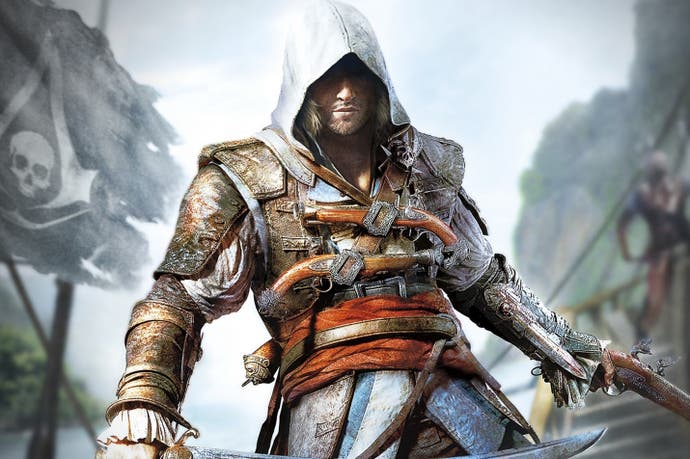Face-Off: Assassin's Creed 4: Black Flag
The state of play on current-gen consoles.
| Xbox 360 | PlayStation 3 | |
|---|---|---|
| Disc Size | Disc One: 6.4GB, Disc Two: 2.8GB | 9.96GB |
| Install | 9.6GB | 4895MB |
| Surround Support | Dolby Digital | Dolby Digital, DTS, 5.1 LPCM |
Planned for release on no less than six different platforms within the space of a month, the development of Assassin's Creed 4: Black Flag has been a mammoth undertaking for Ubisoft in what is clearly one of the biggest cross-generation efforts ever seen, matched only by the upcoming Call of Duty: Ghosts and Ubisoft's own upcoming Watch Dogs. In order to be financially viable, these titles need to be rolled out over both existing current-gen and the new next-gen platforms too. The problem is that - as we have seen to a certain extent with Battlefield 4 - Xbox 360 and PlayStation 3 are in danger of being left behind handing in sub-optimal experiences.
Assassin's Creed 4 seems to be a different kettle of fish. Designed largely around the restrictions of current-generation console technology, it's almost certain that the upcoming Xbox One, PS4 and PC versions of Assassin's Creed won't offer a true revelatory upgrade over the current-gen console editions in the same way that DICE's Battlefield 4 provides. However, the AvilNext engine has been developed with next-generation capabilities in mind, with the ability to scale up feature sets in line with the extra power the Xbox One, PS4 and top-end PCs deliver. As such, an obvious boost in resolution, more stable frame-rates, along with subtler upgrades in lighting and physics are all on the cards - and something that the early code demoed at this year's E3 clearly displayed.
But right now the game is only available for the 360 and PS3, with the other versions due out late in November to correspond with the launch of the next-gen consoles, so we'll have to wait and see just how much the upgrades improve the game as a whole. With that in mind, let's turn our attention to the current Microsoft and Sony formats: does the game yield considerable upgrades over Assassin's Creed 3? Or are we now just looking at subtler refinements to an engine already very well optimised for the hardware?
Kicking off with our head-to-head video and massive comparison gallery, it's clear that there are no surprises on offer in Assassin's Creed 4: Black Flag, with the results closely mirroring that of the previous game.
"Kicking off with our head-to-head video, it's clear that there are few surprises on offer in Assassin's Creed 4 with the cross-platform comparison closely mirroring that of the previous game."
Once again we're looking at a native 720p presentation on both consoles backed up by Ubisoft's in-house post-processing anti-aliasing technology first introduced in Assassin's Creed: Revelations. As expected, the level of coverage on normal edges is rather inclusive, with these areas appearing smooth and well-defined. But similar to other post-AA solutions there are some unwanted side effects that spoil some of the lush artwork on offer throughout the game: fine details and thin strips of geometry suffer from lots of shimmering and pixel popping due to the lack of sub-pixel sampling you get with full-fat multi-sampling. However, the good news is that the algorithm seems identically applied on both platforms down to the pixel level, so neither one gains a distinct advantage in this area, so overall image quality appears closely matched.
In fact, it's hard to even tell the two releases apart from each other at all, even when lining them up side by side for comparison purposes. The quality of the artwork, effects, and the level of detail are a match across both consoles. Looking more closely, it is possible to see textures that are slightly better filtered in the distance on the 360.
The streaming of assets is also handled similarly across both platforms, with general artwork and textures appearing at similar points in both versions. Here, the level-of-detail transition is better managed then the earlier Assassin's Creed titles, so jarring changes in environmental architecture aren't quite so obvious this time around. NPCs still noticeably pop in and out of view when running across the city streets on both consoles though. Some of the transitions are handled via a smoother dithering effect, but we also see characters popping out of nowhere in the "traditional" jarring way too.
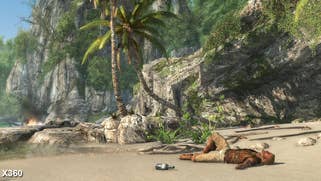
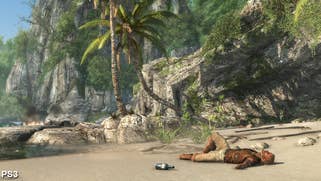
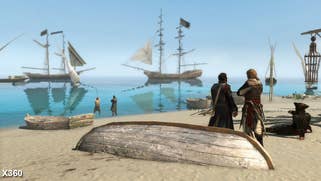
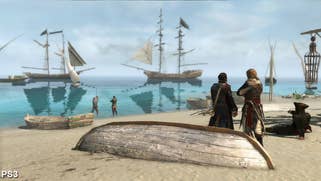




Overall then, it's hardly earth shattering stuff, and the results are pretty much expected after some seven years of Ubisoft's studios working with the 360 and PS3 architectures. As such, the differences here are negligible and have no perceived impact on the overall quality of the visuals, which are some of the most diverse and impressive yet in an Assassin's Creed title.
The reduction of graphical glitches and game-disrupting bugs also represents a clear improvement over Assassin's Creed 3. Besides one point where our character failed to draw his melee weapon in one isolated combat incident, we didn't notice any other severe glitches or instances of flying objects while playing. However, picking up objects when situated next to enemies is still an infuriating process, with the game constantly switching back and forth between character and item interaction without offering the player any choice but to walk away and try again.
Despite appearing similar from a technical perspective, the world presented in Assassin's Creed 4: Black Flag is considerably more open than in the previous game, allowing the player much greater freedom from the outset, and featuring seamless transitions between ship and land gameplay - it's simply a case of jumping off the side and swimming to land. The landscape itself is also detailed and at times beautiful to behold, from small isolated islands to built-up cities under the grip of the military. The world comfortably stretches far into the distance, with effects such as fog, depth-of-field and lighting used to create some atmospheric scenes that set the tone for the range of 1700s-inspired locations.
Time-of-day changes and dynamic weather also bring about a tangible sense of realism to the proceedings, although these elements are initially scripted when starting many main missions, with the developer using this to set the scene for narrative purposes - such as having the player sneak around a military-owned plantation at night, or a by presenting a view of pirates enjoying a drink around the fire on a moonlit beach at night.
"PlayStation owners get an hour's worth of exclusive content, featuring Aveline from AC3 Liberation. These missions should be available to both PS3 and PS4 gamers."
The inclusion of naval battles and exploration by sea is also a clear high point for the series. The use of dynamic weather effects and changes in ocean current, along with the intensity of the waves helps to make sailing the high seas a more authentic experience, and this has a direct impact on how these sections of the game play. In particular, the physics of your ship are affected by the conditions of the sea, currents and the variety of waves constantly tugging away as you navigate from quiet quayside waters into the turbulent open ocean. The ocean itself appears complex in nature and is mostly geometry-based - animated normal maps and texture layers are used to create the ripples and texture of its surface and the effect is impressive. Environments are also reflected on the water's surface, along with light via a specular sheen component, which changes in intensity according to the lighting conditions.
Assassin's Creed 4: Black Flag - performance analysis
Moving onto performance, Assassin's Creed 3 brought about several changes to the series that improved things considerably. The introduction of v-sync brought about an end to the horrendous screen-tearing that plagued previous Assassin's Creed titles, while an uncapped frame-rate helped to enhance top end smoothness, at the expense of additional judder.
Cut from the same cloth as the previous game, it comes as no surprise that Assassin's Creed 4 doesn't deviate far from the established path, offering up a very similar experience. The lack of screen-tearing and use of v-sync is once again a welcome sight, and doesn't appear to have too much of a negative impact on the frame-rate, given how choppy things often are in past Assassin's Creed games when the engine is under load. The decision to run with an uncapped frame-rate also has obvious benefits - such as tangibly increasing top-end smoothness in less demanding scenes - but it means there's a large gap between high and low end fluidity when the engine is put under stress, and the appearance of judder when frame-rates don't fall into a cadence evenly divisible by 60Hz.
"Performance in both Xbox 360 and PS3 is broadly similar - there's a small Microsoft advantage but it's hardly game-changing stuff."
This is most apparent when frantically dashing through more populated areas of the game, such as the central areas of Havana and Nassau, which feature some densely packed environments that put a visible strain in the engine. Here, the increased level of detail and NPCs cause a noticeable hit to the frame-rate, manifesting as a jerky on-screen update along with a drop in the responsiveness of the controls. As we've seen in past games this is something that occurs more frequently on the PS3 in Assassin's Creed 4. Frame-rates often drop down to the mid-twenties in both formats, but we see the PS3 fall between 2-4 frames behind in similar conditions. This has a larger impact on controller response, which makes fluidly traversing the environments rather difficult without accidentally interacting with the surrounding buildings and characters.
These issues are also present in the 360 game though - albeit to a lesser extent - and are just as irritating when they happen, so the experience certainly isn't one of complete consistency on Microsoft's console. Interestingly, during gameplay we frequently see frame-rates above 30fps sustained for short periods on both consoles when scaling the rooftops in Havana and in other similar locations where the engine has more room to breathe in scenes with longer draw distances.
Like-for-like scenes give us a clearer picture of what is going on between both platforms, unaffected by the differences that occur during during gameplay. The metrics here reveal a similar lead for the 360 when the engine is taxed more heavily, but otherwise the two appear quite evenly matched when frame-rates are high - the small 2-4 frame lead is far less obvious when both versions are running at 30fps and above, and we even see the PS3 take the lead in a few scenes for brief moments. Throughout the course of the game's cinematics, Assassin's Creed 4 also exceeds the 30fps metrics favoured by developers this generation, with anything up to 44fps measured at certain points. However, things usually stabilise around the conventional 30fps mark, and drop down closely to 20fps in alpha-heavy sequences set during stormy weather conditions at sea.
"Throughout the course of the game's cinematics, Assassin's Creed 4 also exceeds the 30fps metrics favoured by developers this generation, with anything up to 44fps at certain points."
Assassin's Creed 4: Black Flag - the Digital Foundry verdict
With the groundwork solidly laid down by past titles in the series, it perhaps comes as no surprise that Ubisoft has come so close to achieving complete parity between Xbox 360 and PS3 on its flagship franchise. Bar the slightly more erratic performance and lower frame-rates, the series no longer massively lags behind on Sony's system, and as a result the core experience with Assassin's Creed 4 is generally very good on both consoles once you get past those pesky frame-rate issues. Any minor variances in other areas have no real impact on the quality of the game, and come across as mere rendering oddities as opposed to distinct advantages or compromises where each platform is concerned.
Ubisoft's ability to optimise the AnvilNext engine around different hardware configurations has clearly improved over time, and this also bodes well for the upcoming Wii U version of the game. Assassin's Creed 3 delivered a comparable experience to Sony and Microsoft's systems, despite being one of Ubisoft's first games for Nintendo's new console, so perhaps we could see the developer taking better advantage of the system's modest GPU advantage to further close the gap.
In the here and now Assassin's Creed 4: Black Flag marks another excellent cross-platform release that is well worth picking up for both PS3 and 360 owners respectively. Arguably the 360 version offers up the smoothest overall experience across a general run of play, but that shouldn't stop you from picking up the excellent PS3 game if that is your primary format of choice - and remember that Ubisoft is offering up an hour's worth of additional content for PlayStation owners. This wasn't accessible in the review build we had, so unfortunately we couldn't assess it, but those who enjoyed Aveline's adventures in Vita-exclusive AC3 Liberation might enjoy the continuation of her adventures.
Looking forward, those looking to purchase a PS4 or Xbox One at launch might be better served by waiting for the next-generation versions of the game though. While expecting a full-on cutting edge experience is almost certainly out of the question for a cross-generational title, the prospect of playing in higher resolutions with more stable performance and a range of additional visual upgrades is very appealing indeed.
